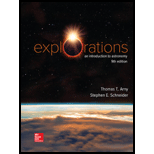
Concept explainers
The three main types of galaxies and find the galaxy differ in their shape, stellar content, and interstellar matter.
Answer to Problem 1QFR
The three main types of galaxies are spiral, elliptical, and irregular galaxy.
The elliptical galaxy are elliptical in shape, it is formed through galactic collision. It has little star formation; there is no interstellar medium.
The spiral galaxy are spiral in shape, it is formed through collision of smaller galaxies. It has rotating flat disc of star, dust and gases. It has large amount of interstellar medium.
The irregular galaxy does not have specific shape; it is formed through external gravitational disturbances. They have large amounts of interstellar medium.
Explanation of Solution
Elliptical galaxy:
Elliptical galaxy formed through galactic collisions. Thus the elliptical galaxy contains between 10 million to 100 trillion stars.
Elliptical galaxies contain metal rich stars that appear orange and red in color. It has no interstellar medium and thus it has very little star formation.
Spiral galaxy:
Spiral galaxies have two or more windings from the center. These galaxies contains mixture of young and old stars, because to make a young star, a galaxy must contains dense clouds of dust and gas
Spiral galaxies have 15% of mass in their disk in the form of interstellar matter,
Conclusion:
Irregular galaxy:
An irregular galaxy is a galaxy that does not have a specific shape. These galaxies are formed from external gravitational disturbance such as another galaxy passing near to it, it has large amount of interstellar medium.
Want to see more full solutions like this?
Chapter 17 Solutions
EXPLORATIONS:INTRO.TO ASTRONOMY
- Why does the disk of a spiral galaxy appear dark when viewed edge on?arrow_forwardWhen comparing two isolated spiral galaxies that have the same apparent brightness, but rotate at different rates, what can you say about their relative luminosity?arrow_forwardArrange the following in order of increasing size: our Milky Way Galaxy; a globular star cluster; a pair of radio lobes around an active galaxy; a giant elliptical galaxy; the Solar System; the Local Group galaxy clusterarrow_forward
 Stars and Galaxies (MindTap Course List)PhysicsISBN:9781337399944Author:Michael A. SeedsPublisher:Cengage Learning
Stars and Galaxies (MindTap Course List)PhysicsISBN:9781337399944Author:Michael A. SeedsPublisher:Cengage Learning Stars and GalaxiesPhysicsISBN:9781305120785Author:Michael A. Seeds, Dana BackmanPublisher:Cengage Learning
Stars and GalaxiesPhysicsISBN:9781305120785Author:Michael A. Seeds, Dana BackmanPublisher:Cengage Learning AstronomyPhysicsISBN:9781938168284Author:Andrew Fraknoi; David Morrison; Sidney C. WolffPublisher:OpenStax
AstronomyPhysicsISBN:9781938168284Author:Andrew Fraknoi; David Morrison; Sidney C. WolffPublisher:OpenStax Foundations of Astronomy (MindTap Course List)PhysicsISBN:9781337399920Author:Michael A. Seeds, Dana BackmanPublisher:Cengage Learning
Foundations of Astronomy (MindTap Course List)PhysicsISBN:9781337399920Author:Michael A. Seeds, Dana BackmanPublisher:Cengage Learning An Introduction to Physical SciencePhysicsISBN:9781305079137Author:James Shipman, Jerry D. Wilson, Charles A. Higgins, Omar TorresPublisher:Cengage Learning
An Introduction to Physical SciencePhysicsISBN:9781305079137Author:James Shipman, Jerry D. Wilson, Charles A. Higgins, Omar TorresPublisher:Cengage Learning




